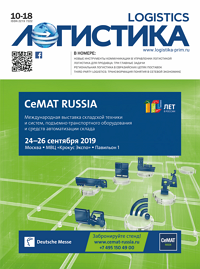Scientific & Practical Journal

Editorial News
Dear readers! We are pleased to present to you the eleventh issue of the journal in 2025. There are a lot of relevant and useful materials in the issue, which, hopefully, will not be ignored.
Dear readers! In September the CeMAT RUSSIA exhibition was held, which showed everyone that innovations and robotics are increasingly penetrating the logistics industry. We can safely say that many technologies are tested here, and only then they go out into the world. However, it is not only CeMAT RUSSIA that demonstrates the prevalence of the digital agenda.
Dear readers! This is the ninth issue of the journal, which turned out to be very rich and diverse. Traditionally, the issue is opened by an analyst. The material by Alina Nasyrova from the Market Guide Agency, dedicated to investments in warehouse complexes in Russia, recalls the importance of developing logistics infrastructure for the integrated development of regions.
PHOTO OF THE WEEK
CITATIONS
«Logistics» Journal № 10 / 2018
WAREHOUSE. INVENTORY MANAGEMENT
Apostore company offers automation solutions for the pharmaceutical industry in Russia
INFORMATION TECHNOLOGIES
Digital logistics technologies: possible prospects and risks of their implementation in the supply chain
Currently, both in Russia and abroad, the issues of digitalization of logistics are given special attention. The use of digital technologies in supply chains is not only associated with obtaining certain advantages, but also with a complex of risks, identification and accounting of which at the decision-making stage to increase the efficiency of the logistics supply system seems to us extremely important.
Key words. Logistics, logistics system, digitalization, digital logistics, digital economy, digital logistics technologies.
INFRASTRUCTURE
Regional logistics in the Eurasian supply chains, Gomel region being the case
The essence of the Chinese initiative «One belt and one way» is revealed. The role of Belarus in the construction of the new Eurasian land bridge is shown. The analysis of the logistics potential of the Gomel region is carried out. The problems of development of the transport infrastructure of the region and ways of their solution are determined. The need to use the opportunities provided by the project for the development of the regional economy is underlined.
Key words. Regional economy, logistics, transport infrastructure, Belarus, Gomel region, «One belt and one way» initiative, new Eurasian continental bridge.
PROBLEMS AND OPINIONS
Third-party logistics: transformation of the concept in the networked economy
The article reveals the features of the transformation of Third-party logistics in the networked economy. The author analyzes the peculiarities of the application of Third-party logistics in various spheres of market relations. Special attention is paid to the influence of Third-party logistics on the development of e-commerce.
Key words. Third-party logistics, logistics providing, network economy, virtual market, marketing logistics, supply chain management, distribution logistics.
This article is a study of various approaches to the definition of the concepts of «transport» and «logistics» infrastructure and argues the position of the need to refrain from using the term «transport and logistics» infrastructure, which, despite being well-established, is not correct. The conducted research of Russian and foreign scientific publications has shown that the transport infrastructure has already been ramped up in the logistics infrastructure, therefore it is illogical to use these terms as equivalent.
Key words. Transport infrastructure, logistics infrastructure, transport, logistics.
Today in the world more than one billion cars are operated, each of which represents not only the vehicle, but also a source of emissions in the atmosphere of the «money» spent by car owners for the fuel which is contained in exhaust gases. At the same time gas emissions of the car not only intensively pollute the environment and bring significant economic damage to car owners, but also interfere with further increase in motor transportation transportations.
Key words. Fuel, engine, system, exhaust gases, car, transport, «excess» fuel.
EDUCATION. PERSONNEL
Training of engineering personnel ‒ the basis of industry development
PROCUREMENT. SUPPLY
Formation of the regulatory basis to calculate the material resources requirements for state institutions
The article deals with the problem of consumption of economic products by public institutions, organizations and enterprises. The economic products are understood as the inventory required to complete the workplaces of employees, and the office supplies necessary to perform the respective functions. The paper reveals a system-wide algorithm to analyze consumption, calculate norms and standards, and to determine the need for economic products. As an example of the algorithm implementation, stationery, consumed in higher education institutions, was chosen.
Key words. Public institutions, public purchases, material resources nomenclature, economic products, stationery, norms and standards for consumption of material resources.












